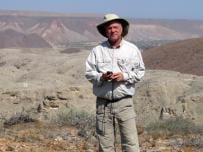Originally Posted: June 6, 2018
Save Nov. 9, 2018 on your calendar. That’s when the Smithsonian’s National Museum of Natural History opens a new exhibit on never-before-seen fossils from Angola. The never-before-seen fossils were discovered, excavated and prepared by SMU faculty and student researchers. They tell the story of how the South Atlantic Ocean formed millions of years ago, and provide clues to understand our planet’s present and future. READ MORE
Ancient “Sea Monsters” Reveal How the Ever-Changing Planet Shapes Life, Past and Present
Never-Before-Seen Fossils From Angola Bring a Strange Yet Familiar Ocean Into View
The Smithsonian’s National Museum of Natural History will open a new exhibition Nov. 9, 2018 revealing how millions of years ago, large-scale natural forces created the conditions for real-life sea monsters to thrive in the South Atlantic Ocean basin shortly after it formed. “Sea Monsters Unearthed: Life in Angola’s Ancient Seas” will offer visitors the opportunity to dive into Cretaceous Angola’s cool coastal waters, examine the fossils of striking marine reptiles that once lived there and learn about the forces that continue to mold life in the ocean and on land.
Over 134 million years ago, the South Atlantic Ocean basin did not yet exist. Africa and South America were one contiguous landmass on the verge of separating. As the two continents drifted apart, an entirely new marine environment — the South Atlantic — emerged in the vast space created between them. This newly formed ocean basin would soon be colonized by a dizzying array of ferocious predators and an abundance of other lifeforms seizing the opportunity presented by a new ocean habitat.
“Because of our planet’s ever-shifting geology, Angola’s coastal cliffs contain the fossil remains of marine creatures from the prehistoric South Atlantic,” said Kirk Johnson, the Sant Director of the museum. “We are honored by the generosity of the Angolan people for sharing a window into this part of the Earth’s unfolding story with our visitors.”
For the first time, Angolan fossils of colossal Cretaceous marine reptiles will be on public display. Through Projecto PaleoAngola — a collaboration between Angolan, American, Portuguese and Dutch researchers focused on Angola’s rich fossil history — paleontologists excavated and studied these fossils, which were then prepared for the exhibition by a team of scientists and students at Southern Methodist University (SMU) in Dallas. The exhibition was made possible by the Sant Ocean Hall Endowment Fund.
 “Fossils tell us about the life that once lived on Earth, and how the environments that came before us evolve over time,” said Louis Jacobs, professor emeritus of paleontology at SMU and collaborating curator for the exhibition. “Our planet has been running natural experiments on what shapes environments, and thereby life, for millions of years. If it weren’t for the fossil record, we wouldn’t understand what drives the story of life on our planet.”
“Fossils tell us about the life that once lived on Earth, and how the environments that came before us evolve over time,” said Louis Jacobs, professor emeritus of paleontology at SMU and collaborating curator for the exhibition. “Our planet has been running natural experiments on what shapes environments, and thereby life, for millions of years. If it weren’t for the fossil record, we wouldn’t understand what drives the story of life on our planet.”
The exhibition will immerse visitors in this Cretaceous environment with lively animations and vivid paleoart murals of life beneath the waves — courtesy of natural history artist Karen Carr — that bring to life 11 authentic fossils from Angola’s ancient seas, full-size fossil reconstructions of a mosasaur and an ancient sea turtle, as well as 3-D scanned replicas of mosasaur skulls. Photomurals and video vignettes will transport visitors to field sites along Angola’s modern rugged coast, where Projecto PaleoAngola scientists unearth the fossil remains from this lost world. READ MORE